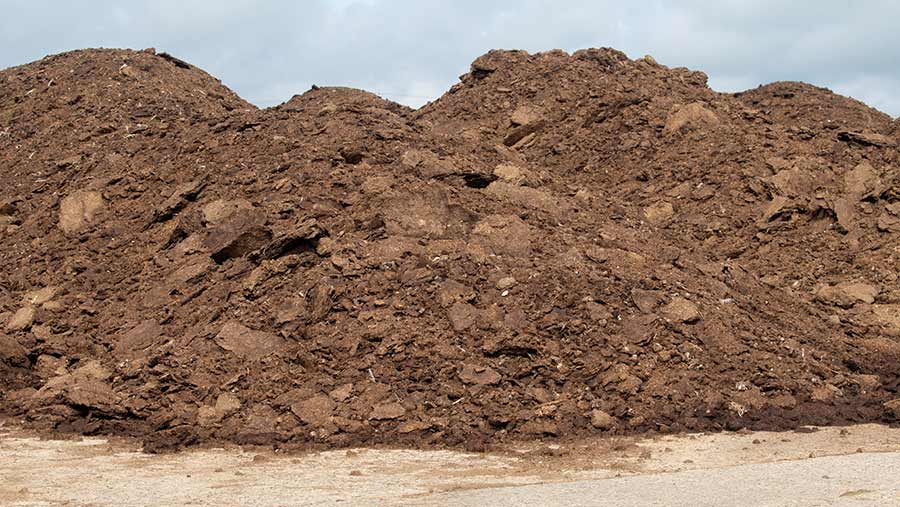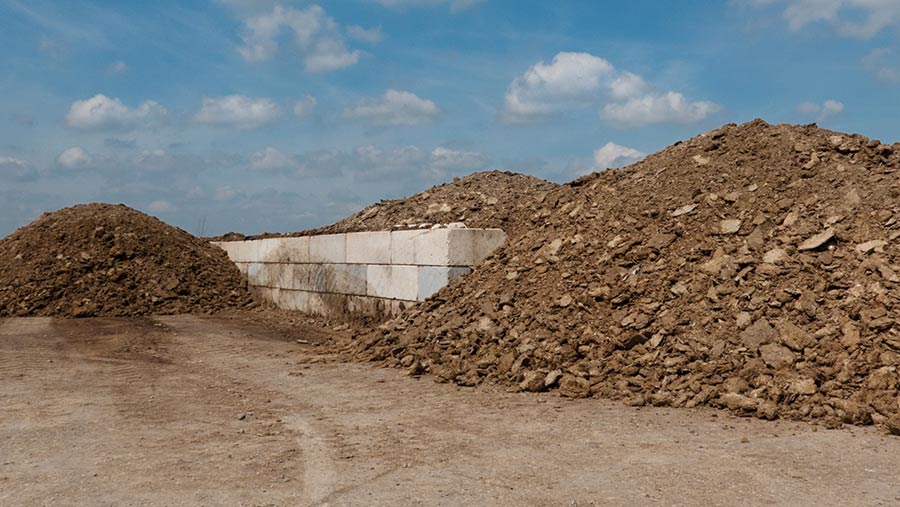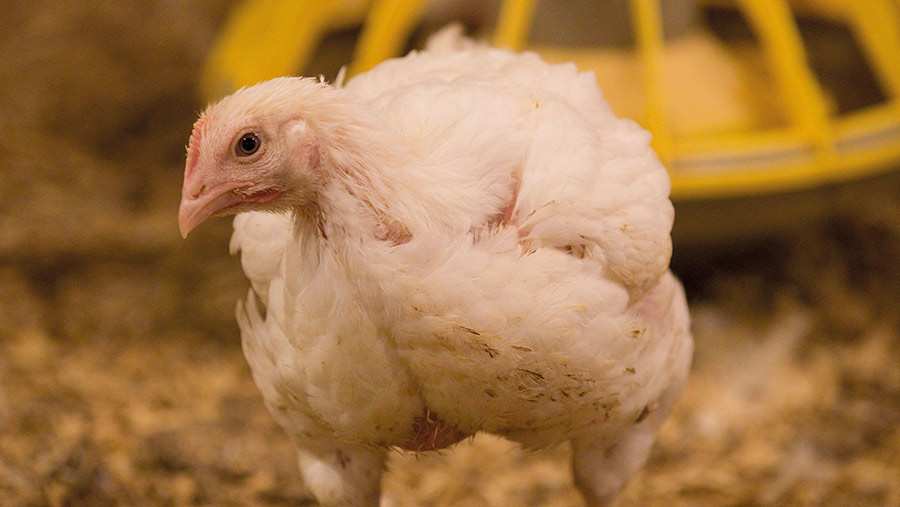5 poultry manure management tactics to protect soils and water
 © Tim Scrivener
© Tim Scrivener Broiler processor Avara recently announced that its suppliers must comply with tighter soil nutrient and manure management rules before spreading poultry manure.
The firm’s move was made in January following high-profile concern over rising pollution levels in the River Wye in Herefordshire.
See also: Local farmers lead clean up of phosphate polluted river
Wildlife groups linked the pollution, notably a hike in phosphate levels, to a rapid expansion in poultry units within the Wye catchment.
Avara decided to devise an action plan to tackle the issue, and poultry market commentators now predict that competitors will follow suit, putting manure management under greater scrutiny.
Soil and grassland specialist Chris Duller outlines the key steps poultry producers can take to protect their soils and the environment.
1. Match application rate to nutrient value
Over-applying poultry manure to fields can have serious consequences for soil, water and air, in the form of harmful methane, carbon dioxide and ammonia emissions.
The phosphate (P) content of typical poultry manure is four times higher than the levels in cattle manure, and nitrogen (N) levels are three times higher.
Recommended application rates – at no more than 1t/acre on grazing land and 2t-3t/acre on silage ground – are therefore considerably lower than the usual 5t/acre application rate for cattle manure.
As well as the pollution risk, applying at higher rates can cause grass to scorch.
Mr Duller says the “gold standard” is to apply poultry litter to arable land during cultivation when it can be incorporated into seed-beds, which are often nutrient-hungry.
“In an all-grass farm, is chicken muck the best nutrient we can use? The answer is no, because losses occur when it sits on top of grass,” he explains.
“Also, because phosphate content is very similar to potash (K), the majority of poultry manure application tends to oversupply phosphate and undersupply potash to grassland.”
Red Tractor rules state that when it is applied to grassland, the field should not be grazed for at least four weeks – and ideally longer – because of the disease risk.
2. Know the indexes of your soils
Always sample soils for nutrient status before applying poultry manure, as indexes could already be high.
If the soil pH is low, the N and P supplied by poultry manure won’t be used efficiently, and reduced plant uptake increases the risk of wastage.
Mr Duller says some of the soils he has sampled on poultry farms are at index 6 for P. The highest indexes are found mostly on long-term grassland where the levels accumulate at the surface.
Once soils reach index 3 for P there is a crop requirement for only 20kg/ha a year of phosphate in a silage system, so 7.5t/ha of poultry manure will oversupply by 70kg P/ha.
“Do that for three years and your soils will jump up an index. It can take 50 years to get the index back from 6 to 2; a farm should definitely not be applying chicken muck on that land.”
Get advice from a professional on how to manage high-index soils, as too much P can be an antagonist against selenium and cause metabolic disorders, such as milk fever, in cattle.
If soils have a low index, values will quickly increase when poultry manure is applied, so sampling should be carried out regularly every three or four years.
If compound fertiliser is applied to land where poultry manure is used, Mr Duller advises using an N and K product and avoiding anything with P in it.

© Matauw/Adobe Stock
3. Set up manure export agreements with other farms
A 32,000-bird system will produce about 14t of manure a week, so at application rates of 2.5-5t/ha, between 140ha and 180ha of land is required for spreading the annual 700t output.
Many farms won’t have that much land, so Mr Duller advises setting up agreements with arable systems where poultry manure is an asset for crop production and cost-competitive with inorganic fertiliser, even accounting for transport costs if done on a local basis.
Government regulations apply to exporting manure, and these differ between the four UK nations. Always check what the requirements are first, and then price the manure according to current input costs.
4. Never mix with other organic manures
A common mistake is storing poultry litter with other manures. In that situation, the nutrient status of the manure will be an unknown.
“It is very difficult to do the sums on rates and to work out what other fertilisers are needed when manures are mixed, so always have distinct heaps for different types,” Mr Duller advises.
Mixing also limits opportunities for spreading other manures in a nitrate vulnerable zone (NVZ), he adds.

© Tim Scrivener
“Poultry manure is classed as a high readily available nitrogen (RAN) manure. So in Wales, for instance, in 2024 farmers will be prevented from spreading those manures between 15 October and 15 January, but there are different rules for cattle manure.
“But if cattle manure is mixed with poultry manure it can’t be applied in that closed period either.”
Regulations do allow field heaps if the manure is covered with an impermeable material.
However, Mr Duller says poultry manure is often unstable and easily slumps in a field heap, so it is best stored in a roofed area.
5. Reduce the volume of manure that needs handling
A trial in Wales demonstrated that spraying layer housing with a stabiliser containing non-infective bacteria, with the aim of dominating the bad bacteria present, significantly dried out litter.
The removal of muck from sheds could be reduced from twice a week to once every 10-14 days, the Farming Connect study showed.
This was because the quantity of muck that needed to be handled was greatly reduced. Another important gain was that there was little or no odour in the treated litter.
Poultry manure spreading regulations
England
As a high-RAN organic manure, poultry muck must not be applied at a rate higher than 8t/ha, and no repeat application is allowed within 21 days.
The Farming Rules for Water state that it must not be applied on grassland with sandy or shallow soil from 1 September to the end of February, or on arable land with that soil type from 1 August to the end of February.
For all other soils that rule is in force from 15 October to the end of February on grassland, and from 1 October to the end of February on arable ground. There are additional requirements for land in an NVZ.
Wales
Farms that spread manure must produce a plan to show that the total N coming from all spread manures will not exceed 250kg N/ha in a 12-month period, and keep records of all application dates and rates.
Closed periods for spreading high-RAN manures will be introduced from 1 August 2024 and will cover the whole of Wales.
Scotland
Applications of poultry manure are controlled under the Water Environment (Controlled Activities) (Scotland) Regulations.
These state that any application must not exceed the crop requirement for N at the time of application or be applied in excess of the amount required to maintain the target soil P status.
Northern Ireland
Under Nutrients Action Programme (NAP) regulations, poultry manure can be applied to land only if the farmer can demonstrate that the total amount of available P will not exceed a crop’s needs.
This must take into account the soil P index, the recommended soil P index for the crop, and P supplied by the application of other fertilisers.
